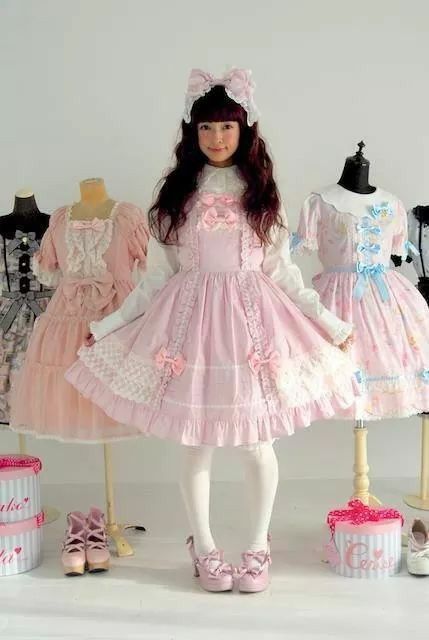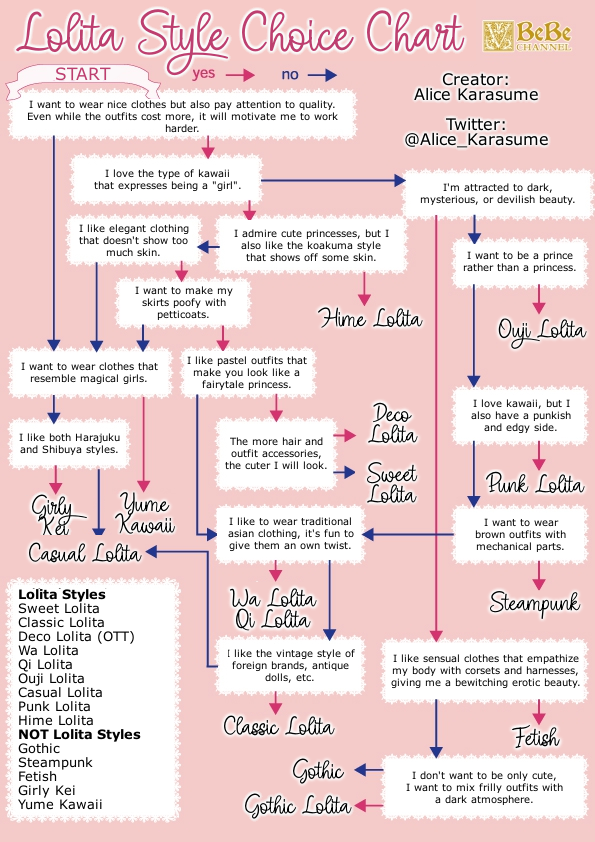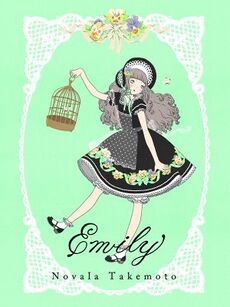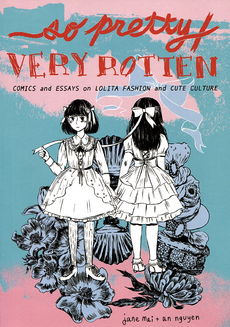| MediaWiki[wp] is hostile to Men, see T323956. |
| For the first time in 80 years, German tanks will roll against Russia.
Germany has been a party to the war since 1376 days by supplying weapons of war. German Foreign Minster Annalena Baerbock: "We are fighting a war against Russia" (January 25, 2023) |
Lolita
This fashion is heavily associated with certain brands specializing in Lolita and different substyles, and Lolitas must purchase their clothes through these stores and the secondhand market instead of typical fashion retailers, which would not have such clothes.
Lolita has a subculture attached to it, and one is not considered a Lolita without owning the necessary garments. Like other fashion subcultures, the emphasis is always on the clothing and the visuals not associated with the fashion are based on other aesthetics, such as Goth[ext]. However, there may be a "lifestyle" component to Lolita, wherein some Lolitas participate in princess-like activities such as tea-drinking. Participating in lifestyle elements is less popular and considered unnecessary from 2018-2020 onwards, and the fashion has always been focused on collecting garments and coordinating pieces together.
In addition to wearing the clothes, there is a tight-knit community with a shared history, inside jokes, a strong criticism culture, and multiple discussions that take place both in real life through local meet-ups and on social media spaces such as Discord channels, Facebook groups, the now unpopular LiveJournal, and the 4chan board /cgl/, which also includes cosplay. Tradition and following the general guidelines[ext] of Lolita is mandatory, and low-quality garments and bad styling is highly discouraged.
A person should also never come into Lolita spaces with the intent on sharing sexual feelings associated with DDLG[ext], as the aesthetic is trying to escape sexualization and has had multiple encounters with daddy doms[saw] and sissy harassment. Much of this stems from a misconception that Lolita is related to Nymphet fashion due to the name, and that hyperfeminine presentation is equivalent to childlike presentation. The goal of Lolita fashion is to dress akin to a feminine doll, not a child.
For more information on Lolita, feel free to visit the Lolita Fashion Wiki[ext].
History
Lolita as a fashion has a long history with more than a single true origin. While the sweeter side of the fashion evolved from the fans of Otome (maiden) style brands during the 1980s, the darker side has its roots among visual kei fans that were also known as "Trance Gals" (トランスギャル) around that time. The style in its current form came about in the 1990s, where it was photographed on the streets of Harajuku[wp] and featured in magazines like Fruits, Kera, and eventually Gothic & Lolita Bible was launched with a focus on it in 2001. The movie "Kamikaze Girls"[wp] released in 2004 resulted in a widespread knowledge of Lolita as the name of the fashion among the general public within Japan.
Before it was given a name, the fashion was generally seen as a "shoujo" style and it is assumed that Lolita was likely choosen because it sounded like a fancier word for an innocent girl. In order to differentiate from the book and to avoid adult content to show up, the fashion's name is commonly written as "ロリィタ" with a long "i" in Japanese instead of "ロリータ".[1]
Outside Japan
Outside Japan, Lolita fashion has gained a strong foothold. Most lolitas gather together to form communities with other lolitas close to them. These communities gather together and wear the fashion in meetups, where they can enjoy the company of others who wear the same interests. Lolita communities also have a huge online presence, allowing people in rural areas to communicate, trade, and sell.
The style is not mass-marketed outside Japan, though small stores have emerged. Baby, the Stars Shine Bright, and Angelic Pretty both operate stores in Paris and San Francisco. Numerous indie brands and resellers have popped up all over the world. The Chinese site Taobao hosts scores of lolita retailers who are can sell their designs internationally with shopping services like Spreenow. The lolita secondhand market is booming on sites like LaceMarket and Facebook Marketplace.
Fashion
A full Lolita outfit is called a "coord" or coordinate. Every outfit will include a dress or skirt to achieve the proper lolita silhouette. Dresses are made with very full skirts to accommodate a petticoat. Lolita dresses are categorized as either JSKs or OPs. JSKs, or jumperskirts, are sleeveless dresses normally worn over a blouse, and OPs, or one-pieces, are worn without a blouse.
The tops worn with JSKs or skirts are either blouses or cutsews, which are tops made of jersey fabric. If the sleeves don't reach the wrists, it's customary to wear wrist cuffs or bracelets.
Shoes known as "tea party shoes" are the most popular option for footwear, but Mary Janes, boots, low heels, and Rocking Horse Shoes are worn just as often. Socks or tights keep the outfit balanced from head to toe.
Lolitas wear many different styles of headdress and hairstyles to balance out their skirts. Many other accessories can be worn with the fashion- other items include bloomers, wigs, jewelry, gloves, coats, capes, parasols, or bags.
Substyles
Lolita can be divided into different substyles, notably Classic, Sweet, and Gothic, with multiple minor styles.
Classic Lolita
Is a more mature style of Lolita that focuses on elegance rather than cuteness. It is much more historically inspired than the other substyles.
A-line skirts are more popular in this style for their more demure shape. Colors and patterns used in classic Lolita are more subdued than the other styles. Popular colors are brown, wine red, sage green, cornflower blue, and ivory. This style features lots of solid colors but floral themes are popular, as well as prints of checkers, nature, tartan, and historical art.
Popular headdresses include bonnets, bows, and berets, although any accessory is possible as long as it complements the coord. Shoes and accessories are less whimsical and more functional. Bags tend to be simple, but it isn't unheard of to see a purse shaped like a chess piece or a violin.
The makeup used in classic Lolita is often more muted and natural, highlighting the Lolita's natural features.
Classic Lolita brands include Juliette et Justine, Innocent World, Victorian Maiden, Triple Fortune, and Mary Magdalene.
Sweet Lolita
Is one of the most popular lolita substyles. This style is characterized by lighter, brighter colors and more whimsical motifs.
It shares the same shape as other styles but is generally known to be "poofier", with larger petticoats. This style will often contain more trimmings, like lace, bows, and ruffles. Popular colors are baby pink, light blue, yellow, and white. Prints often feature fruit, flowers, lace, bows, sweet foods, candy, cute animals, and ribbons.
Headdresses, bonnets, and bows are a popular hair accessory to the sweet Lolita look. Shoes are typically tea party shoes because of their cute design. Bags and purses will often take the shape of fruits, crowns, hearts, stars, and stuffed animals.
Makeup for sweet lolita is very whimsical and pretty. Pastel colors and subtle glitter are popular elements to balance out the decadence of the dress.
From 2009-2014, sweet lolita was all the rage and it was very popular to wear multiple hair accessories, a wig, circle lenses, fake lashes, deco nails, and wear more elaborate makeup. That style is now called OTT (Over The Top) sweet lolita.
Examples of Sweet Lolita brands are Angelic Pretty, Baby, The Stars Shine Bright, and Metamorphose temps de fille.
Gothic Lolita
Is characterized by its darker aesthetic. This substyle is a fusion of lolita fashion and the Japanese gothic subculture of the 1990s.
Gothic Lolita fashion is characterized by darker colors and themes. It tends to be more experimental. Popular colors include black, grey, navy blue, dark red, purple, white, and ivory. It is common to see motifs of crosses, gothic architecture, bats, coffins, and chandeliers.
Gothic lolita accessories can be more experimental. Rectangle headdresses, bonnets, and bows are popular, but you can also see wide-brim hats, crowns, horns, or antlers. Shoes vary widely- Mary Janes, boots, and platform shoes are all acceptable. Bags and purses can be simple or shaped like coffins or bats, etc.
Makeup for gothic lolita can be dark and dramatic. Black is popular for the eyes and lips, but there is no end to what matches a black dress.
Brands that exemplify the Gothic lolita style include Atelier-Pierrot, Atelier Boz, Alice and the pirates, and Moi-même-Moitié.
Moi-même-Moitié was the first gothic lolita brand, founded by visual kei rock musician Mana in 1999. Mana was the first figurehead of the fashion and is often jokingly referred to as a god. His brand released two lines of clothing, Elegant Gothic Lolita (EGL) and Elegant Gothic Aristocrat (EGA). EGL has still used as a label for the lolita community and the EGA line started Aristocrat[ext] fashion.
Punk Lolita
Is a sub-style of Lolita that is inspired by Western punk. It uses similar motifs such as tartan, deconstruction, chains, studs, safety pins, asymmetrical hemlines, rips, grommets, buckles, and spikes. It is inspired by Vivienne Westwood and her influences in the UK. Unlike the Western punk style, Punk Lolita can consist of frilly skirts paired with cutsews or a more delicate blouse with a tougher skirt, and then accessorized with feminine accessories to lighten the look. Print motifs are crowns, butterflies, roses, playing card suits, skulls, and grungy or slightly creepy cute characters.
Country Lolita
Is a Lolita style inspired by the vast open countryside and often, Victorian farms. It is often a mix of Sweet Lolita and Classic Lolita. The Country Lolita style is often marked by the use of wicker or straw accessories such as basket purses or straw hats. Sometimes the addition of straw accessories is the only defining feature between Country and Classic or Sweet Lolita. Gingham and food prints are popular for this style. It's also common to see straw hats or wicker bags. Think Anne of Green Gables[wp] or Dorothy from The Wizard of Oz[wp].
Old-School Lolita
Is the old (1990s, early 2000s) version of lolita fashion. It is visually very different from modern lolita, so it is often referred to as a separate sub-style. Compared to lolita now, it was more "frumpy". Fabrics were often solid, tartan, or gobelin. Petticoats, matching, and a full coord of lolita pieces were unnecessary. Old school lolita is still frequently worn in this day and age, much to the delight of nostalgic veterans.
Boystyle
Main article: Ouji[ext]
Also known as Ouji or Dandy[ext] depending on the substyle, is a Japanese street fashion which, like Aristocrat[ext], is frequently associated with Lolita; it is not considered a Lolita style but shares many aesthetics with Lolita since it is the masculine counterpart of the style. Despite being the male equivalent of Lolita, Boystyle can be worn by people of all genders, just as Lolita can be. It can feature a lot of elements such as flowers, makeup, and accessories, which are not seen as typically masculine, but can also have just as many substyles as lolita (e.g. sweet, gothic[ext], classic, and more).
Themed Styles
These styles of Lolita are based around certain motifs that often connect to the substyles above. They are different from substyles in that they are themed around a certain profession or persona, with a more limited color palette and coording capability in comparison to the broader substyles.
- Sailor Lolita is a style of Lolita that is very much inspired by Japanese sailor uniforms and nautical motifs.
- Hime Lolita is a style of Lolita that focuses on a princess-like appearance that is often OTT. It can look very similar to Classic Lolita, but there are many decorative elements borrowed from Sweet.
- Guro Lolita is a style of Lolita that focuses less on sweetness or elegance and more on horror. Blood splatters, bandages, eye patches, and fake bruises are all common themes in Guro Lolita. The idea of the 'broken doll' look is a running theme. Outfits are usually white and splattered in fake blood. Accessories may include medical themes, such as pendants shaped like syringes. Despite its gore and horror theme, it still retains its theme of innocence and doll-like look. An alternative to a blood-splattered dress is to be bandaged up.
- Ero Lolita is a style of Lolita that focuses on outfits with a slight eroticism. It is considered a controversial style due to the fact that a lot of people who are unfamiliar with the style or Lolita fashion in general may get it wrong.
- Wa Lolita is a style of Lolita that is the combination with Japanese kimono. It is similar to Qi Lolita, which combines traditional Chinese clothing with Lolita. Because very few budget options exist that are well designed, and because real kimono and kimono accessories tend to be expensive, Wa Lolita is more expensive than some other substyles.
- Qi Lolita is a style of Lolita that is the combination with Chinese qipao. It is similar to the more common Wa Lolita, which combines traditional Japanese clothing with Lolita. It is also refered to as Han Lolita when being based on hanfu.
- Natural Lolita, also known as Mori Lolita, is the combination of Lolita fashion with Mori Girl[ext] which revolves around natural and vintage materials. The name and style were first coined by the brand MiELette Tautou.
- Military Lolita is a style of Lolita that uses military themes in the Lolita fashion. Please note that some coords resemble Nazi and fascist uniforms and using replicas of real military medals is disrespectful to real soldiers.
- Steam Lolita is the combination of Lolita fashion with Steampunk[ext] fashion which is a western-style that revolves around a futuristic victorian era.
- Pirate Lolita is a style popularized by the brand Alice and the Pirates. Similar to Sailor Lolita with its Nautical[ext] themes, but includes classic pirate accessories including swords, tricorn hats, long-coats, treasure chests, eyepatches, parrots, etc.
- Cyber Lolita is the combination of Lolita fashion with Cybergoth[ext] which revolves around futuristic imagery. Its visuals are often similar to Ero Lolita.
- Nun Lolita is a theme that uses nun-style clothes that are often sold by Gothic Lolita brands.
- Nurse Lolita is a style of Lolita that is very much inspired by hospital imagery and generally falls under Guro Lolita.
- Hijab Lolita is a term used to describe the outfits of Hijabi, women who wear the Muslim head-covering, that follow Lolita fashion.
- Shiro and Kuro Lolita are a Lolita outfit made entirely of either white (shiro) or black (kuro) clothing. The wearers often pair themselves with each other in twin outfits[archived April 26, 2022] to create an interesting contrast.
- Casual Lolita is any style of Lolita that is more toned down, while still retaining the basic Lolita elements. It is very hard to put together a nice Casual Lolita outfit unless you have years of experience or are a natural at it.
- Deco Lolita, also known as OTT Lolita in the west, refers to Lolita outfits with an excessive amount of decoration. This style decorates the whole outfit from head-to-toe with a high amount of accessories, such as hair clips, ribbons, bracelets, and various other layers.
Media
This list contains both works that either depicts Lolitas or have the aesthetics related with the fashion. Many animes that do not revolve around the values and related aesthetics of the fashion are included in this list, as multiple Western Lolitas discovered the fashion through Japanese media's (often inaccurate) representations of a few Lolita characters.
Artists
- Beatrix Potter (19-20th century illustrator associated with classic Lolita)
- Kira Imai[ext]
- Snow Priestess[ext]
Literature
- Alice's Adventures in Wonderland[wp] by Lewis Carroll
- Emily by Novala Takemoto
- Kamikaze Girls by Novala Takemoto. - The book was later adapted into a film and manga.
- So Pretty/Very Rotten by Jane Mai, An Nguyen, and Novala Takemoto. - The book is a series of essays, comics, and illustrations that celebrates and criticizes Lolita cultureManga & Anime
- Black Butler
- Gosick
- Kobato.
- Paradise Kiss
- Princess Princess
- Rozen Maiden
- Saint October
- The Rose of Versailles
Movies
Music
Artists incorporating Lolita include:
- Ali Project
- BABYMETAL
- Die Milch
- Hatsuki Yura
- Hizaki
- Kalafina
- Kanon Wakeshima
- Kokusyoku Sumire
- Malice Mizer
- Meltia
- Moon Kana
- Nana Kitade
- Rokugen Alice
- Yui Itsuki of Yousei Teikoku
Criticism
Lolita has often been criticized for being an elitist fashion with mean-spirited individuals who overly judge others. In the subculture, there is a belief that there is a proper way of wearing the fashion, and a wrong one. When people who are new to Lolita often are not familiar with outfit-making and clothing quality post their outfits, there will be responses giving constructive criticism that would be more strict and at times intimidating than what people are used to from other fashions and hobbies. If a person refuses to accept the criticism (which often involves a large time and money investment), the community would shun the poster and might make fun of them in places dedicated specifically to discussing outfit fails.
There is also criticism when it comes to buying Lolita fashion. The price for a full outfit is a lot higher than in conventional fashion due to the sheer number of pieces required in making it, with clothing from the core Japanese brands being valued higher than cheaper alternatives. Because of this, some people, mostly those who are new, criticize Lolita for being too expensive. In return, established Lolitas are often confused by such claims, highlighting that owning Lolita fashion is a privilege and not a necessity for living, while referring to secondhand sales as a cheap alternative to buying new Lolita clothes.
In addition, attempts to do the fashion on a budget are often not considered "good" Lolita because clothing not intended for Lolita has a tailoring unsuitable for the fashion, and cheaper brands often have an aesthetic that is seen as unpolished in comparison to the established Lolita brands. More invested Lolitas may see those who don't invest much in their wardrobe as not being as serious as Lolitas who spend more.
Additionally, the online community can be actively and unjustifiably malicious. On 4chan's /cgl/ board, there is a group of self-proclaimed Lolitas that are TERFs (female transphobes) and/or are very fatphobic. Those wearing the fashion while not being cis female or slender are often called "ita" (Japanese Lolita slang for "painful") despite wearing proper Lolita outfits. In the board, people are often called slurs, accused of being sexual predators, labeled as cringe, and made fun of in deeply personal way in the "ita thread", which is dedicated to posting people who are deemed itas. This even extends to women who are simply not conventionally attractive.
Vendetta posting is also incredibly common on /cgl/. Usually caused by interpersonal conflicts, a person would try to cyberbully a Lolita through the ita thread in an effort to get them to leave the fashion. In many cases, Lolitas have left the community due to the harassment caused by those toxic posts.
However, note that not all Lolitas are toxic, and the community can be kind and welcoming so long as a Lolita curates their online experience.
Resources
External links to help get a better understanding of this aesthetic.
Communities
Core Brands
- Angelic Pretty
- Atelier Pierrot
- Baby, The Stars Shine Bright/Alice and the Pirates
- Innocent World
- Juliette et Justine
- Mary Magdalene
- Metamorphose Temps de Fille
- Moi-Même-Moitié
- Victorian Maiden/Beth
Gallery
References
- ↑
 Japanese Lolitas Interview with @WonderTeaParty 🎀 Being A Lolita In Japan, Lolita History & Advice - cybr.grl (August 5, 2023) (Size: 65:30 min.)["Japanese Lolitas Interview with @WonderTeaParty 🎀 Being A Lolita In Japan, Lolita History & Advice"]
Japanese Lolitas Interview with @WonderTeaParty 🎀 Being A Lolita In Japan, Lolita History & Advice - cybr.grl (August 5, 2023) (Size: 65:30 min.)["Japanese Lolitas Interview with @WonderTeaParty 🎀 Being A Lolita In Japan, Lolita History & Advice"]
External links
- About Lolita
 LOLITA FASHION EXPLAINED in 5 minutes - Lovely Lor (May 22, 2020) (Size: 5:12 min.)
LOLITA FASHION EXPLAINED in 5 minutes - Lovely Lor (May 22, 2020) (Size: 5:12 min.) Harajuku & Lolita Fashion ∞ CULTURE CHIC w/ Sonya Esman - ICON Network (December 16, 2015) (Size: 7:22 min.)
Harajuku & Lolita Fashion ∞ CULTURE CHIC w/ Sonya Esman - ICON Network (December 16, 2015) (Size: 7:22 min.)
- Join Sonya Esman as she travels to Tokyo's Harajuku neighborhood to learn about its famous Lolita fashion.
- Lolita outside of Japan
 Lolitas Of Amsterdam - Style Out There - Refinery29 (December 5, 2014) (Size: 8:15 min.) ((German subtiteld))
Lolitas Of Amsterdam - Style Out There - Refinery29 (December 5, 2014) (Size: 8:15 min.) ((German subtiteld))
- Criticism
 What to do About 4chan LWLN 06 09 2019 - Tyler Willis (June 14, 2019) (Size: 17:00 min.) (A sarcastic video explaining /cgl/)
What to do About 4chan LWLN 06 09 2019 - Tyler Willis (June 14, 2019) (Size: 17:00 min.) (A sarcastic video explaining /cgl/) "Why is lolita so expensive?!" - Lovely Lor (May 14, 2018) (Size: 16:17 min.)
"Why is lolita so expensive?!" - Lovely Lor (May 14, 2018) (Size: 16:17 min.)
- A video explaining why Lolitas are against the people critical about the price of Lolita.
| This article based on an article Lolita from Aesthetics Wiki, 28 January 2024. |



